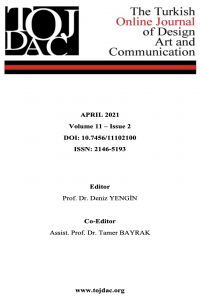Abstract
Bu çalışmada, dönemin siyasal ideolojisinin etkilerini ve yansımalarını gösteren Sovyet animasyon sinemasının ürettiği ideolojik söylemler incelenmiş, bulunan bulgular doğrultusunda bu animasyon filmlerin Sovyetlerin siyasal tarihini ve toplumsal kültürünü yansıtan bir çeşit kültürel hafıza oluşturduğu irdelenmiştir. Makaledeki ideolojik söylem analizi yöntemi Teun A. van Dijk’in Ideological Discourse Analysis başlıklı makalesi dikkate alınarak uygulanmıştır. Çalışma kapsamında ideolojik söylemler incelendiği için Sovyet animasyonları arasında yalnızca propaganda içerikli olan kısa filmler ele alınmış ve çalışmanın kapsamı sınırlandırılmıştır. Ayrıca filmlerle ilgili alınan tarih aralığı Sovyetler Birliği’nin resmi animasyon stüdyosu olan Soyuzmultfilm dönemidir. 1936 yılında faaliyetlerine başlayan stüdyonun 1991 yılında Sovyetler Birliği’nin dağılmasına kadar geçen sürede ürettiği filmler dikkate alınmıştır. Söylem analizinde bulunan bulgular Ideological Discourse Analysis makalesinde belirtilen ‘öz-kimlik’, ‘aktivite’, ‘hedef’, ‘norm ve değer’, ‘konum ve ilişki’ ve ‘kaynak’ başlıkları üzerinden değerlendirilmiş ve Sovyet animasyon sinemasındaki ideolojik söylemler çözümlenmiştir.
References
- Bendazzi, Giannalberto. (1995). Cartoons: One Hundred Years of Cinema Animation. Indiana University Press.
- Bocharov, Victor. (2004). A Belated Premiere, Documentary. Russia: Gosfilmfond Rossiyskoy Federatsii.
- Eisenstein, Sergey. (1993). Sinema Sanatı. Çev. Nilgün Şarman. İstanbul: Payel Yayınevi.
- Fairclough, Norman. (2001). “Critical Discourse Analysis as a Method in Social Scientific Research”. Introducing Qualitative Methods: Methods of Critical Discourse Analysis. SAGE Publications.
- Kapkov, Sergey. (2006). Entsiklopediya otechestvennoy mul'tiplikatsii. Moscow: Algoritm-kniga.
- Lozhkov, Dmitry. (2013). “Rol' propagandy v Sovetskom Soyuze po probleme formirovaniya obshchestvennogo mneniya po voprosam sovetsko-amerikanskikh otnosheniy v 1970-ye gody”. Gosudarstvennoye upravleniye Elektronnyy vestnik. 38, s. 189-200.
- Moritz, William. (1997). “Ladislas Starewitch”. The Oxford History of World Cinema. Oxford University Press.
- Sawicki, Mark. (2010). Animating with Stop Motion Pro. Oxon: Taylor & Francis.
- Sevindi, Koray. (2020). Sovyet Propaganda Animasyonlarında İdeolojik Söylem. Marmara Üniversitesi Sosyal Bilimler Enstitüsü, Yayınlanmamış Doktora Tezi.
- Taylor, Richard. (1998). Film Propaganda: Soviet Russia and Nazi Germany. New York: I. B. Tauris.
- van Dijk, Teun. (1995). “Ideological Discourse Analysis”. Interdisciplinary Approaches to Discourse Analysis (The New Courant). Vol: 4, Helsinki: University of Helsinki - Department of English.
- Animator.ru Animation Database. https://www.animator.ru/db/?ver=eng&p=films (Last Accessed: January 10, 2021).
Abstract
In this study, the Soviet animation cinema's ideological discourses, which showed the consequences and reflections of the political ideology of the era, were examined. In line with the findings, it was considered that these animated films constitute a kind of cultural memory that exhibits the political history and social culture of the Soviets. The article's ideological discourse analysis method was applied by considering Teun A. van Dijk's study titled Ideological Discourse Analysis. As part of this research, because ideological discourses were analyzed, only short films with propaganda content were regarded among Soviet animations, and the scope of the study was restricted. Furthermore, the date range taken about the films was the term of Soyuzmultfilm, the official animation studio of the Soviet Union. The films created by the studio, which began its actions in 1936 until the dissolution of the Soviet Union in 1991, were taken into account. The conclusions of discourse analysis were evaluated according to the headings 'self-identity', 'activity', 'goal', 'norm and value', 'position and relation' and 'resource' mentioned in the article Ideological Discourse Analysis, and the ideological discourses in Soviet animated cinema were analyzed.
References
- Bendazzi, Giannalberto. (1995). Cartoons: One Hundred Years of Cinema Animation. Indiana University Press.
- Bocharov, Victor. (2004). A Belated Premiere, Documentary. Russia: Gosfilmfond Rossiyskoy Federatsii.
- Eisenstein, Sergey. (1993). Sinema Sanatı. Çev. Nilgün Şarman. İstanbul: Payel Yayınevi.
- Fairclough, Norman. (2001). “Critical Discourse Analysis as a Method in Social Scientific Research”. Introducing Qualitative Methods: Methods of Critical Discourse Analysis. SAGE Publications.
- Kapkov, Sergey. (2006). Entsiklopediya otechestvennoy mul'tiplikatsii. Moscow: Algoritm-kniga.
- Lozhkov, Dmitry. (2013). “Rol' propagandy v Sovetskom Soyuze po probleme formirovaniya obshchestvennogo mneniya po voprosam sovetsko-amerikanskikh otnosheniy v 1970-ye gody”. Gosudarstvennoye upravleniye Elektronnyy vestnik. 38, s. 189-200.
- Moritz, William. (1997). “Ladislas Starewitch”. The Oxford History of World Cinema. Oxford University Press.
- Sawicki, Mark. (2010). Animating with Stop Motion Pro. Oxon: Taylor & Francis.
- Sevindi, Koray. (2020). Sovyet Propaganda Animasyonlarında İdeolojik Söylem. Marmara Üniversitesi Sosyal Bilimler Enstitüsü, Yayınlanmamış Doktora Tezi.
- Taylor, Richard. (1998). Film Propaganda: Soviet Russia and Nazi Germany. New York: I. B. Tauris.
- van Dijk, Teun. (1995). “Ideological Discourse Analysis”. Interdisciplinary Approaches to Discourse Analysis (The New Courant). Vol: 4, Helsinki: University of Helsinki - Department of English.
- Animator.ru Animation Database. https://www.animator.ru/db/?ver=eng&p=films (Last Accessed: January 10, 2021).
Details
| Primary Language | English |
|---|---|
| Journal Section | Makaleler |
| Authors | |
| Publication Date | April 1, 2021 |
| Submission Date | February 2, 2021 |
| Acceptance Date | February 10, 2021 |
| Published in Issue | Year 2021 Volume: 11 Issue: 2 |

